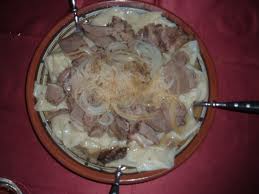Kyrgyz Cuisine
Kyrgyz Cuisine
Every nation wants to preserve and develop the best of its ancestral legacy. The latter includes culture, literature, music, handicraft, traditions, and national recipes. His is why I would like to tell you about the traditional cuisine of Kazakhstani Kyrgyz community.
Generally speaking, Kyrgyz people have a long history, a powerful culture, and a brave, active, sober, and freedom-loving nature.
Kyrgyz cuisine has both adopted the best of Central Asian traditions and preserved its ethnic authenticity.
Kyrgyz everyday life and customs are similar to ours. Such dishes as beshbarmak, shuzhyk, kuyrdak and kumis are the highlights we share. Meat and dairy foods as well as pastry are widely popular with Kyrgyz people. However, their cuisine has its own peculiar features determined by every day and festive traditions. Some Kyrgyz foods are cooked specifically for holidays and traditional events. The former include Sherne, Zhero, childbirth, harvest, etc. In previous years, each holiday feast consisted of a specific set of foods.
For instance, uuz-ash (cooked of colostrum) and nooruz-ash are dishes cooked to celebrate the Muslim New Year, while syumyolyok was cooked to pay tribute to Baba Dikan. Special dishes were cooked during autumn slaughter, immediately before moving to summer pastures, and at harvest time.
As traditions have changed, some of the dishes are not cooked any more. However, some have acquired a new symbolic meaning and are still cooked today.
Chon kyozhyo is an ancient dish. Its trivial name is New Year Soup, spring soup, or big soup. It was traditionally cooked on the first day of Nowruz (March 22 or 23) to celebrate Muslim New Year.
On that day, the entire used to gather; a big fire was made in the step. Children jumped over it, while adults said, “May the bad things go away. A new year has come, and the old one is gone.” After that, everybody sat at a big table to eat chon kyozhyo, which was cooked in a pot large enough to meet the demand.
To prepare it, you pour water into a pot and put meat into it. When the water begins to boil, you add mung beans, millet, and corn. You cook it for 30-40 minutes, and then add rice, millet, white corn, and other cereals.
After the grains are ready, you add diced potato and carrots.
You mix flour and oatmeal with warm water and pour the mixture into the pot. Finally, you add chopped onions, garlic, and pepper to your taste. Each ingredient contributes to the unique taste of chon kyozhyo. There is only a slight difference between it and our nawruz kozhe.
Syumyolyok stimulates the human immune system and helps clean the body.
First, prepare large grain sprouts. When each grain is 3-4 cm long, you mince it with a meat mincer. You pour water over it, stir, and strain with the help of cheesecloth. You pour water again; give it a good stir, and sieve. You mince what remains of the grains, add water, and sieve.
You heat cotton oil to a high temperature, cool it, and add flour to the pot. You stir it thoroughly and add a small amount of yeast.
You put it over fire and stir all the time to prevent burning.
Syumyolyok should be thick and viscous.
Before removing it from the fire, add sugar and let boil for a while. Serve it cool.
Another ancient Kyrgyz dish that is still popular is kyochyo. Back in the old times, people used to cook it with dried corn, millet, and wheat. They put the grains into a small barred, added a little water and stirred to peel the grains. They mashed the grains and used a wide-mesh sieve to screen it. Then, the grains were soaked in water for 5-6 hours. The method is still popular in some areas of Kyrgyzstan.
Nowadays, the amount of cereals (millet, barley, etc.), which makes cooking much more convenient. Ready-to-use cereals make a number of dishes, including kyochyo, easier to cook.
You pour water into a pot, add salt and cereals to your taste, and cook slowly till ready to serve.
You put flour or oats into a glass of water, stir the mixture till smooth and add to the pot. You boil it for 20-25 minutes. The dish can be served both hot and cold. You can add kefir or syuzmyo (cottage cheese). This dish can be cooked regardless of the season.
Uuz ash (colostrum broth). The dish can be cooked with any cereal filling, such as rice, white corn, or even with pasta.
It is an old tradition of Kyrgyz aul to visit one’s relatives or neighbors when their cow drops a calf. Uuz ash is cooked to celebrate the occasion. The tradition has not been forgotten in Kyrgyz auls.
Colostrum is the principal ingredient of the dish.
Usually, cow milk is not used for cooking before 7 or 8 days have passed. The milk collected during the first two days is called kara uuz, which means black colostrum. It turns sour soon, so it cannot be used for uuz ash. It is mostly used to cook qatiq. Uuz ash is made of milk collected no earlier than on the third milking day.
You add cereals to the water, salt it to your taste, add colostrum, and keep it boiling for a while. Serve it slightly cooled.
Most of the recipes described above contain cereals.
Assem Zharymbkova
 Қысқа да нұсқа. Жазылыңыз telegram - ға
Қысқа да нұсқа. Жазылыңыз telegram - ға